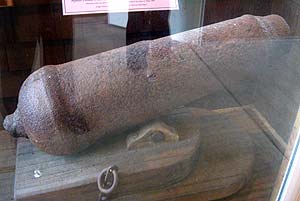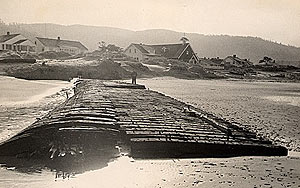Five Funky Facts About Oregon Coast Shipwrecks You Didn't Know
Published 10/21/2015 at 6:22 PM PDT - Updated 10/21/2015 at 6:32 PM PDT
By Oregon Coast Beach Connection staff

(Oregon Coast) – That which has wrecked on the Oregon coast has many tales to tell. Indeed, sometimes it's even changed the local landscape in some way. (Above: the wreck of the Emily G. Reed, which only appears every few decades).
If you're looking for an interesting glimpse into the past of this shoreline, what has happened with its shipwrecks is endlessly fascinating. Here are five funky facts you likely didn't know about the ill-fated vessels of the area.
 Piece of a Shipwreck Gave Cannon Beach Its Name. In September of 1846, a United States schooner called the USS Shark wrecked near Astoria, just a ways up the Columbia River. The ship was a total loss, but all hands got off safely.
Piece of a Shipwreck Gave Cannon Beach Its Name. In September of 1846, a United States schooner called the USS Shark wrecked near Astoria, just a ways up the Columbia River. The ship was a total loss, but all hands got off safely.
It was in so many pieces that chunks of it were found all over the north Oregon coast. One of the four cannon on board the vessel was first spotted in Arch Cape – 25 miles south of the original wreck - by a mail carrier only a couple of months after the 1846 shipwreck. It was seen a couple more times over the decades, along with the other two cannon, but the others disappeared after a while. It wasn't until 1898 that it was pulled out of the sand, after which it spent a good 30 years on at least one homestead in Arch Cape.
That cannon caused the area around Arch Cape to be called Cannon Beach for a brief period, until the larger settlement to the north officially acquired that name in the 20's.
The original sat outdoors the entire time until 2005, when it found a home in the front display at the Cannon Beach History Center. The capstan from the ship also resides there.
During this century, everyone wondered where the other cannon had gone. They were discovered in Arch Cape in 2008 during an extreme low sand level event, more than 150 years after they drifted here. They are currently sitting at the Columbia River Maritime Museum in Astoria.
Mysterious Manzanita Galleon Almost ID'd. Somewhere just before 1700 a Spanish galleon wrecked near Manzanita, on the Nehalem Spit, not far from the mouth of the Nehalem River. Since then, chunks of beeswax with numbers carved into them have been found along these beaches – something that has greatly slowed since the 70's, however.
There was – and still is – rampant talk of the crew having buried treasure in the hills of what is now Neahkahnie Mountain. Many point to the Neahkahnie gated community as the likely spot where something hides beneath the dirt.
That ship, and the host of wild legends surrounding it, had always been a mystery.
Then, in the early 2010's, the PBS show History Detectives looked into it and discovered the beeswax came from one of two Spanish vessels: the Santo Cristo de Burgos or the San Francisco Xavier. They did this by matching the numbers on the beeswax with ship inventory from Spain at that time.
Other strange facts are associated with this galleon shipwreck, however, some of which go all the way back to observations by Lewis and Clark. From their time here in 1805-06 and onward, explorers talked about meeting natives here who were part white and apparently had European lineage. Some even said they were descended from the crew of the galleon.
 Peter Iredale Shipwreck in World War 2. The only time the continental U.S. was fired upon by a foreign power during World War II happened at Fort Stevens, on the north Oregon coast. A Japanese submarine suddenly started firing shots onto the beaches one night in the early 40's, narrowly missing the Wreck of the Peter Iredale, which had lodged in this spot in 1906.
Peter Iredale Shipwreck in World War 2. The only time the continental U.S. was fired upon by a foreign power during World War II happened at Fort Stevens, on the north Oregon coast. A Japanese submarine suddenly started firing shots onto the beaches one night in the early 40's, narrowly missing the Wreck of the Peter Iredale, which had lodged in this spot in 1906.
The guns of the submarine created craters the size of a man, and some were scattered in and around the wreckage, although none hit it directly. It was unharmed by this one-sided battle between the U.S. and Japan.
The massive guns of Battery Russell did not fire back at the submarine because it did not want to give away the location of American weaponry at that site. Ironically, decades later, the captain of the Japanese sub admitted he did not know such a base was there, and he would not have fired on the area had he known this.
 Rockaway Beach Shipwreck Seen Once in 35 Years. One shipwreck on the north coast remains remarkably shy and mysterious. (At right: what the wreck looked like not long after crashing here).
Rockaway Beach Shipwreck Seen Once in 35 Years. One shipwreck on the north coast remains remarkably shy and mysterious. (At right: what the wreck looked like not long after crashing here).
The Emily G. Reed has only been seen once in 35 years, after a low sand level event in 2010 showed about 100 feet of its ribcage. That had been buried since the 70's.
The Reed had been wrecked here – or at least part of it – since 1908, when it crashed into the mouth of the Nehalem River. Some of it broke up and washed up in a spot near the main access at Rockaway Beach. It was seen fairly often through the 40's and 50's, but gradually less and less after that, until it wasn't seen at all after the mid 70's.
It has not been seen since 2010 and it doesn't look likely to appear again, possibly for decades. Sand levels on the Oregon coast are not getting as low as they used to during winter, and current climate predictions don't bode well for erosional storms anytime soon.

Exploding Ship Near Depoe Bay. You can still see the remnants of this on the central Oregon coast at Boiler Bay. In fact, this shipwreck is how the bay got its name. (Seen above).
On the 25th of May, 1910, the steam schooner J. Marhoffer caught fire in the mid afternoon, causing all to abandon ship. With no one to pilot, the ship went kind of bonkers all by itself. It continued rushing towards the shore, and at one point made a full circle in the ocean and then exploded. At this point, it was close enough to shore that the flames actually burned part of the trees on the bluffs of its future resting place: Boiler Bay. Shortly after exploding, it finally hit the rocky edges of the bay and split in two.
The aft section (tail end) drifted off, while the forward section stayed, eventually being picked apart or decaying, so that only the boiler is left. You can, of course, still see the rustic tank in the bay at lower tides. Below: the shipwreck in 1910. You can find more on the Marhoffer at the Lincoln County Historical Society and museum in Newport. 545 SW 9th Street, Newport, Oregon. 541-265-7509.

More About Oregon Coast hotels, lodging.....
More About Oregon Coast Restaurants, Dining.....
LATEST Related Oregon Coast Articles
Brookings events, Gold Beach events, Port Orford events, Coos Bay events, Bandon events, Florence events, Yachats events, Newport events, Lincoln City events, Rockaway Beach events, Manzanita events, Cannon Beach events, Seaside events, Astoria events
Oregon and Coastal Authorities on Lookout for Invasive Species on Boats
Boat inspection units will be all over, from the coast to eastern Oregon. Marine sciences
Outdoors and Rugged on N. Oregon Coast: Upcoming Events Near Astoria, Netarts...
June 20 and 27 at Fort Stevens, July 11 at Shore Acres, July 5 at Netarts. Coos Bay events, Astoria events, Oceanside events
Oregon Coast Road Work and Some Traffic Issues Coming for Bandon, Coquille, G...
Garibaldi, Mist and Coquille this week; 101 closes briefly near Bandon in Sept
NEW: Portland, Oregon Highway Traffic, Road Conditions - Traffic Cams: I-5 - ...
Travel Advice: Traffic Cams for I-5, I-205, I-405, Hwy 217, I-84, OR 26
Low Tide Oceanside Events Take You Deeper Into N. Oregon Coast Tidepools
June 13, 26, 27, and 28, these uncover the wonders at the water's edge. Oceanside events, Pacific City events, Tillamook events, Netarts
Military Truck Tours Back at Fort Stevens, Go Back in Time on N. Oregon Coast
Hop aboard a five-ton military truck and rove around the grounds. History. Astoria events, Warrenton
Newport Astrophotography Events Bring the Universe to Central Oregon Coast
July 25 at Frank Wade Park, August 16 at Newport Rec Center, Aug. 23 - 24 road trip. Nwport events
Back to Oregon Coast
Contact Advertise on BeachConnection.net
All Content, unless otherwise attributed, copyright BeachConnection.net Unauthorized use or publication is not permitted












































